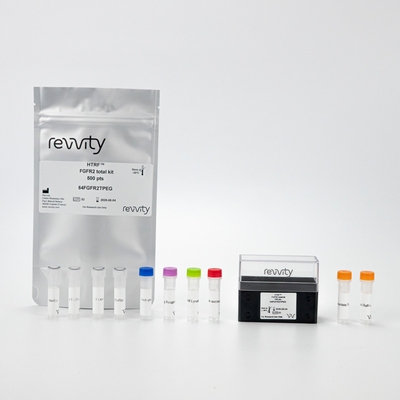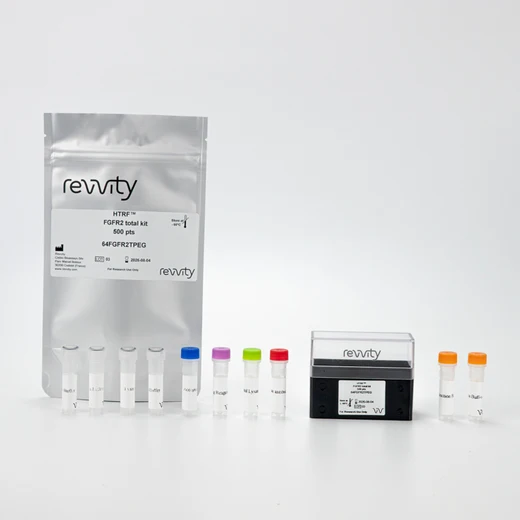

HTRF Human Total FGFR2 Detection Kit, 10,000 Assay Points


HTRF Human Total FGFR2 Detection Kit, 10,000 Assay Points






The Total-FGFR2 kit monitors the cellular FGFR2 expression level, and can be used as a normalization assay for the Phospho-FGFR2 kit.
| Feature | Specification |
|---|---|
| Application | Cell Signaling |
| Sample Volume | 16 µL |
The Total-FGFR2 kit monitors the cellular FGFR2 expression level, and can be used as a normalization assay for the Phospho-FGFR2 kit.



HTRF Human Total FGFR2 Detection Kit, 10,000 Assay Points



HTRF Human Total FGFR2 Detection Kit, 10,000 Assay Points



Product information
Overview
The Total-FGFR2 cellular assay monitors total FGFR2, and is used as a normalization assay with the Phospho-FGFR2 kit. Mutations in FGFR2 have been associated with cancer (breast, melanoma) and abnormal bone development (cranosynostosis syndromes).
Specifications
| Application |
Cell Signaling
|
|---|---|
| Brand |
HTRF
|
| Detection Modality |
HTRF
|
| Lysis Buffer Compatibility |
Lysis Buffer 1
Lysis Buffer 2
Lysis Buffer 3
Lysis Buffer 4
Lysis Buffer 5
|
| Molecular Modification |
Total
|
| Product Group |
Kit
|
| Sample Volume |
16 µL
|
| Shipping Conditions |
Shipped in Dry Ice
|
| Target Class |
Phosphoproteins
|
| Target Species |
Human
|
| Technology |
TR-FRET
|
| Therapeutic Area |
Oncology & Inflammation
Rare Diseases
|
| Unit Size |
10,000 Assay Points
|
Video gallery

HTRF Human Total FGFR2 Detection Kit, 10,000 Assay Points

HTRF Human Total FGFR2 Detection Kit, 10,000 Assay Points

How it works
Total-FGFR2 assay principle
The Total-FGFR2 assay quantifies the expression level of FGFR2 in a cell lysate. Contrary to Western Blot, the assay is entirely plate-based and does not require gels, electrophoresis or transfer. The Total-FGFR2 assay uses two labeled antibodies: one coupled to a donor fluorophore, the other to an acceptor. Both antibodies are highly specific for a distinct epitope on the protein. In presence of FGFR2 in a cell extract, the addition of these conjugates brings the donor fluorophore into close proximity with the acceptor and thereby generates a FRET signal. Its intensity is directly proportional to the concentration of the protein present in the sample, and provides a means of assessing the proteins expression under a no-wash assay format.

Total-FGFR2 2-plate assay protocol
The 2 plate protocol involves culturing cells in a 96-well plate before lysis then transferring lysates to a 384-well low volume detection plate before adding Total FGFR2 HTRF detection reagents. This protocol enables the cells' viability and confluence to be monitored.

Total-FGFR2 1-plate assay protocol
Detection of total FGFR2 with HTRF reagents can be performed in a single plate used for culturing, stimulation and lysis. No washing steps are required. This HTS designed protocol enables miniaturization while maintaining robust HTRF quality.

Assay validation
Assessment of FGFR protein levels in various human cancer cell lines
Different human cancer cell lines were seeded in T175 flasks in complete culture medium at 37°, 5% CO2. The cells were then lysed with 3 mL of supplemented lysis buffer #4 (1X) for 30 minutes at RT under gentle shaking.
25 µg of total protein for each cell line and 15 µg for KG-1 cell line were analyzed for their total FGFR1-2-3 and -4 protein levels. 16 µL of normalized samples were transferred into a 384 well low volume white microplate, and 4 µL of each HTRF Total FGFR1-FGFR2-FGFR3 or FGFR4 detection antibodies were added. The HTRF signal was recorded after an overnight incubation. The results reveal a differential expression pattern for the four different FGFR receptors. Whereas FGFR1 is expressed at high levels in the DMS114 cell lung cancer model and the KG-1 bone marrow myelogenous leukaemia model, FGFR2 is preferentially expressed in SNU-16 and Kato-III gastric cancer model, FGFR3 in the KMS-11 multiple myeloma cell line and FGFR4 in the MDA-MD-453 breast cancer model or HuH7 hepatocarcinoma cell line. Moreover, these results demonstrate the recognition specificity provided by the HTRF Total-FGFR kits.

Inhibition measured with Phospho-FGFR2 (Tyr653/654) & Total-FGFR2 kits on SNU-16 cells
Human SNU-16 cells (gastric cancer) were seeded in a half area 96-well culture-treated plate at 100,000 cells/well in 25 µL complete culture medium. Cells were treated with 5 µL of increasing concentrations of AZD4547, an FGFR Inhibitor, for 6h at 37 °C, 5% CO2. After treatment, cells were lysed with 10µl of supplemented lysis buffer #4 (4X) for 30 min at RT under gentle shaking.
After cell lysis, 16 µL of lysate were transferred into a 384-well sv white microplate, and 4 µL of the HTRF Phospho-FGFR2 (Tyr653/654) or Total-FGFR2 detection reagents were added. The HTRF signal was recorded after an overnight incubation at room temperature.
As expected, the results obtained show a dose-response inhibition of FGFR2 Y653/654 phosphorylation upon treatment with AZD4547, while the FGFR2 expression level remains constant.

Inhibition measured with Phospho-FGFR2 (Tyr653/654) & Total-FGFR2 kits on Kato-III cells
Human Kato-III cells (gastric cancer) were seeded in a half area 96-well culture-treated plate at 100,000 cells/well in 25 µL complete culture medium. Cells were treated with 5 µL of increasing concentrations of AZD4547, an FGFR Inhibitor, for 6h at 37 °C, 5% CO2. After treatment, cells were lysed with 10µl of supplemented lysis buffer #4 (4X) for 30 min at RT under gentle shaking.
After cell lysis, 16 µL of lysate were transferred into a 384-well sv white microplate, and 4 µL of the HTRF Phospho-FGFR2 (Tyr653/654) or Total-FGFR2 detection reagents were added. The HTRF signal was recorded after an overnight incubation at room temperature.
As expected, the results obtained show a dose-response inhibition of FGFR2 Y653/654 phosphorylation upon treatment with AZD4547, while the FGFR2 expression level remains constant.

Inhibition measured with Phospho-FGFR2 (Tyr653/654) & Total-FGFR2 kits on NCI-H716 cells
Human NCI-H716 cells (colorectal adenocarcinoma) were plated in a 96-well plate (100,000 cells/well) and incubated overnight. Cells were treated with a dose-response of AZD4547 for 6H at 37 °C, 5% CO2. After treatment, cells were lysed with 50µl of supplemented lysis buffer #4 (1X) for 30 min at RT under gentle shaking.
After cell lysis, 16 µL of lysate were transferred into a 384-well sv white microplate, and 4 µL of the HTRF Phospho-FGFR2 (Tyr653/654) or Total-FGFR2 detection reagents were added. The HTRF signal was recorded after an overnight incubation at room temperature.
As expected, the results obtained show a dose-response inhibition of FGFR2 Y653/654 phosphorylation upon treatment with AZD4547, while the FGFR2 expression level remains constant.

HTRF Total-FGFR2 assay compared to Western Blot
SNU-16 cells were cultured in a T175 flask in complete culture medium at 37°C, 5% CO2. After 72h incubation, the cells were lysed with 3 mL of supplemented lysis buffer #4 (1X) for 30 minutes at RT under gentle shaking.
ASerial dilutions of the cell lysate were performed using supplemented lysis buffer, and 16 µL of each dilution were transferred into a low volume white microplate before the addition of 4 µL of HTRF Total-FGFR2 detection reagents. Equal amounts of lysates were used for a side by side comparison between HTRF and Western Blot.
A side by side comparison of Western Blot and HTRF demonstrates that the HTRF assay is 32-fold more sensitive than the Western Blot, at least under these experimental conditions.

Simplified pathway
Simplified FGFR signaling pathways
FGFRs are tyrosine kinase receptors activated by the binding of FGF ligands. This binding drives receptor homodimerization, leading to the activation of the FGFR tyrosine kinase domain and specific tyrosine residue phosphorylation. The activated receptor is a docking site for a variety of proteins that induce downstream activation of several signal transduction cascades, including the RAS-MAPK, PI3K-AKT, PLCγ, and STAT pathways. FRS2α is a key adaptor protein constitutively associated with FGFRs. The activated FGFRs phosphorylate FRS2, allowing the recruitment of GRB2 and SOS to activate RAS and the downstream RAF and MAPK pathways, particularly ERK1/2. Via GAB1, GRB2 also activates PI3K which then phosphorylates AKT. Independently of FRS2, the binding of PLCg to the intracellular part of the activated FGFRs leads to the production of IP3 and DAG by the hydrolysis of PIP2. DAG activates the enzyme PKC, which partly reinforces the activation of the MAPK pathway. Depending on the cellular context other pathways are also activated by FGFRs, such as STAT signaling. The signals transmitted from the FGFRs to the nucleus lead to the regulation of various biological functions such as cell proliferation, differentiation, survival, adhesion, migration, and angiogenesis. Alterations of FGFRs in a wide variety of cancers are associated with the overexpression or hyperactivity of FGFRs, making the receptors key targets for anti-cancer therapies.

Resources
Are you looking for resources, click on the resource type to explore further.
This guide provides you an overview of HTRF applications in several therapeutic areas.


How can we help you?
We are here to answer your questions.






























